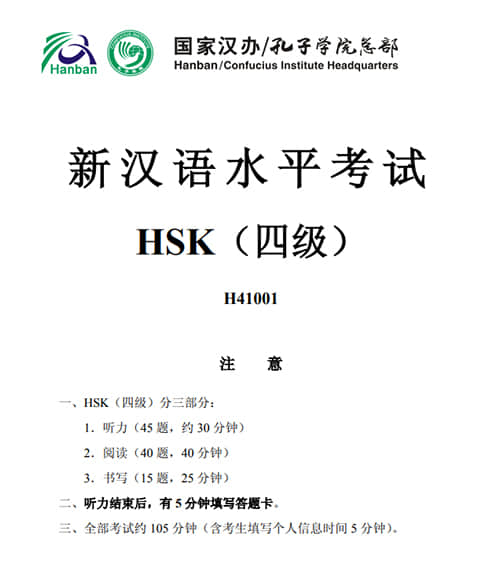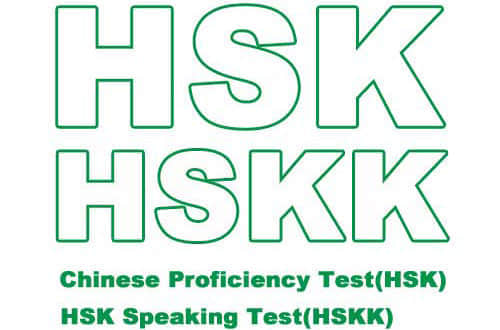What is the HSK?

The HSK (Hanyu Shuiping Kaoshi) is a standardized test to measure the Chinese language ability of non-native speakers in their daily, academic and professional lives. It is the abbreviation for Chinese pinyin “HANYU SHUIPING KAOSHI”. Chinese students call it Chinese IELTS, or Chinese TOEFL. The HSK is divided into 6 levels: level 1-2 for beginners, level 3-5 for intermediates, and level 6 for advanced. Candidates can pass the tests depending on their own language ability, and don’t need to take all exams in order.
What are the contents of the New HSK examination?
Level 1-2 consists of listening and reading, level 3-5 consists of listening, reading and simple writing, and level 6 consists of listening, reading and writing a piece of 1000 words.
Take level 5 as an example:
| Task | Description | Approximate time |
|---|---|---|
| Listening | 2 tasks, containing 45 questions | 30 minutes |
| Reading | 3 tasks | 45 minutes |
| Writing | 2 tasks | 40 minutes |
Is New HSK level 4 good enough to communicate with Chinese people?
The HSK proficiency levels are comparable to the levels in the Chinese Language Proficiency Scales for Speakers of Other Language (CLPS) and the Common European Framework (CEF)as reference:
| New HSK | Vocabulary | Chinese Ability | CLPS | CEF |
|---|---|---|---|---|
| HSK (Level 6) | Over 5,000 | Easily comprehend written and spoken information in Chinese and can effectively express themselves in Chinese, both orally and on paper. | Level V | C2 |
| HSK (Level 5) | 2500 | Read Chinese newspapers and magazines, enjoy Chinese films and plays, and give a full-length speech in Chinese. | Level V | C1 |
| HSK (Level 4) | 1200 | Converse in Chinese on a wide range of topics and are able to communicate fluently with native Chinese speakers. | Level IV | B2 |
| HSK (Level 3) | 600 | Communicate in Chinese at a basic level in their daily, academic and professional lives. They can manage most communication in Chinese when travelling in China. | Level III | B1 |
| HSK (Level 2) | 300 | Grasp of basic Chinese and can communicate in simple and routine tasks requiring a simple and direct exchange of information on familiar and routine matters. | Level II | A2 |
| HSK (Level 1) | 150 | Understand and use very simple Chinese words and phrases, meet basic needs for communication and possess the ability to further their Chinese language studies | Level I | A1 |
According to the information officially published about the HSK, test takers who passed the HSK Level 4are able to communicate fluently with native Chinese speakers.
In general, most candidates would like to take level 4 as their first target. But if you want to work in China, you will need further study.
While passing the HSK exam is a good basis for communication, it will be quite a challenge when you meet people who have a strong accent.
What are tips to prepare for the HSK?

1. Choose a right level for your own Chinese ability and make sure you have the right vocabulary list according to the HSK level that you are practicing.
2. Download or buy the text book and work books required for the HSK, and then learn it by whatever is the best method for you, such as finding a private teacher or a coaching class, or searching for a partner to study with, and then learn by practicing listening and speaking via video, audio and with flashcards.
3. Drill the vocabulary and grammar rules to grasp sentences. Vocabulary and grammar are a great foundation for learning Chinese.
4. Do exercises and mock exams. You can find the HSK Official Test Exams online, which provide mock tests and real exams from previous years, and you can do a self-evaluation test. Then, check your answers and find out the reason why you made mistakes.
5. Have dialogues with Chinese natives if you can.
How hard is it to pass the HSK?
 A copybook in Chinese
A copybook in Chinese Chinese characters may be your first point of difficulty. Chinese writing uses characters that are pictographic. Learners have to break down the character into its constituent components to create a memory-aid, and then make a connection with its meaning and pronunciation. Those are not the sound-meaning characters cannot help with character acquisition.
Additionally, anyone learning a new language needs to understand its culture. As Chinese word order is quite different from Indo-European word order and the difference of cultural background may be a great puzzle for non-native learners. A friend on the Internet site ‘Quora’ said that the HSK exams require using a particular word to complete a sentence. For example 黄牛, literally, means ‘cattle’, but in context it points to ticket resale.
Another good example is 买卖 which means “business”. Now take this sentence: ‘Even peddlers accept Alipay to do business.’ You may not even understand the example if you don’t know what Alipay is and how widely and frequently Chinese people use Alipay in their daily lives.
Like any language, idioms in Chinese can also be frustrating to learn and understand their meaning. Most of the Chinese idioms have a long history and connect with a historical story, which can contain more information in fewer words than today’s vernacular Chinese. It’s not easy to remember idioms and the hardest part is to truly understand their usage. Some idioms not only have a literal meaning but also have intended meaning. Learners need to remember at least some well-known ones.
Obviously, the New HSK content contains Chinese popular and traditional culture; practicing beyond exams you will find pleasure from learning Chinese.

 Chinese Language Learning Tour in Beijing
Chinese Language Learning Tour in Beijing  China Culture Exchange and Language Learning Tour for Students
China Culture Exchange and Language Learning Tour for Students  Immersion Chinese Learning Program in Guilin
Immersion Chinese Learning Program in Guilin  Top 7 Ideas for a School Trip to China
Top 7 Ideas for a School Trip to China